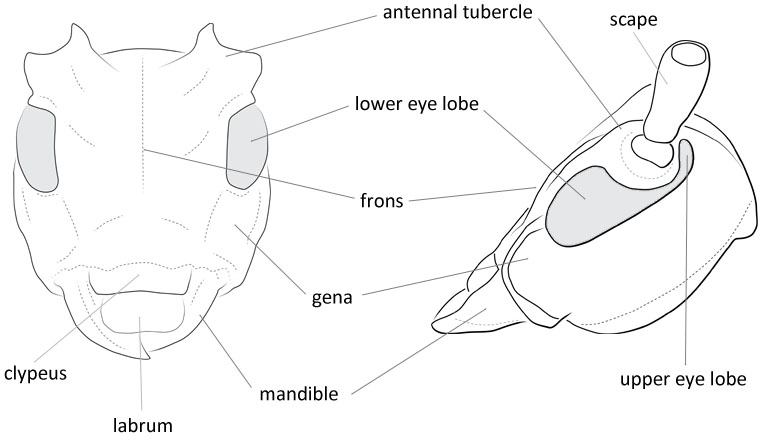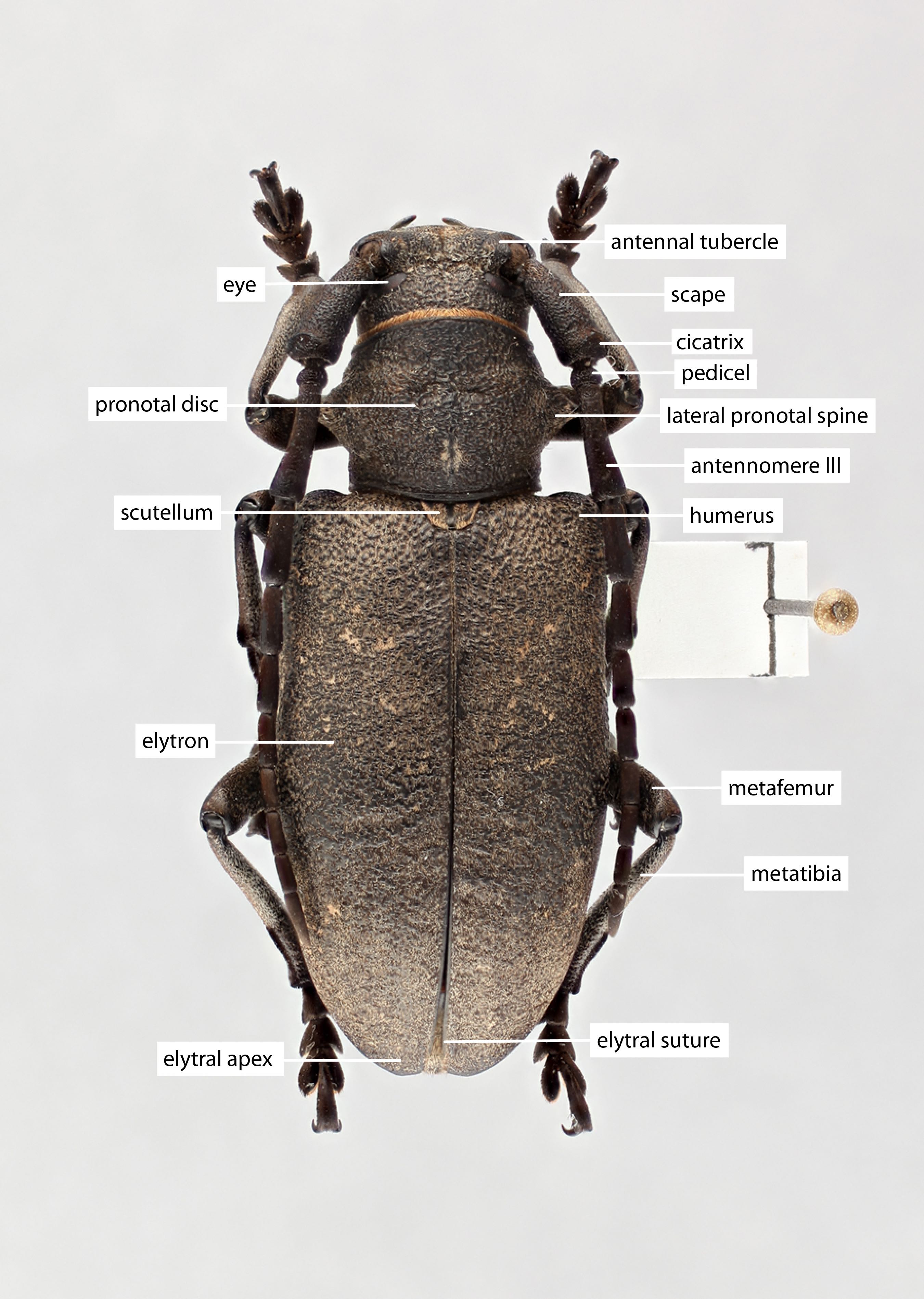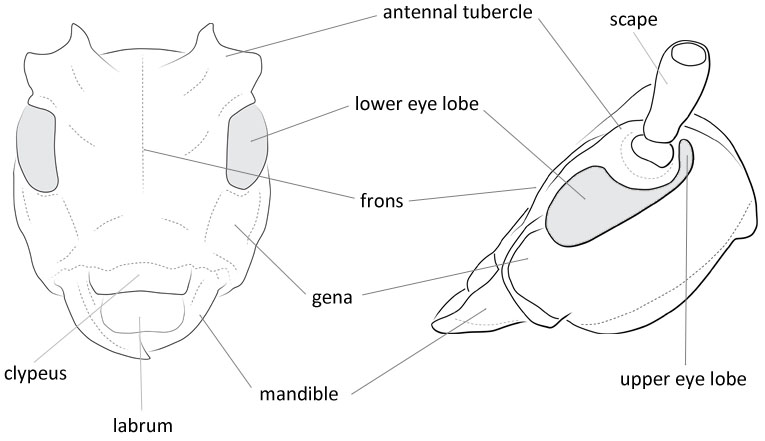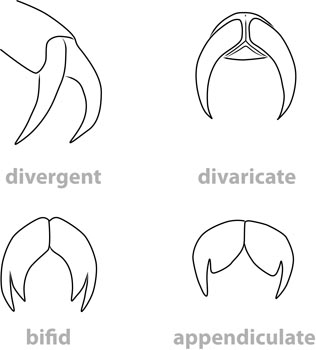Monochamus nigromaculatus Gressitt, 1942: 2
Length: 17.7 mm.
Elytral length:width ratio: length > 2x width.
Face: shape wide rectangle; genagena:
the part of the cranium on each side below the eye length longer than lower eye lobeeye lobe:
length longer than lower eye lobeeye lobe:
used to refer to the upper or lower portion when the eye is emarginate or separated or subequal to lower eye lobeeye lobe:
or subequal to lower eye lobeeye lobe:
used to refer to the upper or lower portion when the eye is emarginate or separated .
.
Pronotum:pronotum:
the upper and dorsal part of the prothorax
dense setaeseta:
a sclerotized hair-like projection of the cuticle
on dorsum of lateral spines absent; maculaemacula:
a spot or mark
on pronotal disk: 2–4 dots present; posteromedial tubercletubercle:
a small knoblike or rounded protuberance
present; lateral erect setaeseta:
a sclerotized hair-like projection of the cuticle
: absent.
Scutellum:scutellum:
a small sclerite located directly posterior to the pronotum, bordered laterally by the elytra pubescence broken at least partially along midline.
pubescence broken at least partially along midline.
Elytra:elytron:
the leathery forewing of beetles, serving as a covering for the hind wings, commonly meeting opposite elytron in a straight line down the middle of the dorsum in repose
elytral integument color black; elytral maculaemacula:
a spot or mark
: dense velvety pubescentpubescent:
downy; clothed with soft, short, fine, loosely set hair
patches present, pubescence forming narrow longitudinal lines, rarely pubescence forming horizontal band(s); elytral sutural apexapex:
end of any structure distad to the base
rounded; elevation in basal third followed by impression absent; basal granulation dense and coarse; middle to apical punctationpunctation:
pits or depression of variable size in cuticle
coarse.
Aedeagus:aedeagus:
in male beetles, the penis
paramereparamere:
A pair of finger-like structures that are located where the male genitalia exits the abdomen.
mediobasal tooth present; apical tip (ventral view) slightly rounded; terminal segment absent; scleritesclerite:
any hardened plate of the body wall bounded by membrane or sutures; sometimes found floating in the internal sac of male genitalia
in internal sac: scleritesclerite:
any hardened plate of the body wall bounded by membrane or sutures; sometimes found floating in the internal sac of male genitalia
absent.
Original description: Body black, tinged with red-brown on tibiaetibia:
the leg segment distal to the femur, proximal to the tarsus
and 3rd and following antennal segments; surfaces clothed with gray-white, black, and buff pubescence as follows: head sparsely flecked with gray hairs; antennaeantenna:
in larval and adult insects, paired segmented appendages, borne one on each side of the head, functioning as sense organs and bearing a large number of sensilla
ringed with whitish on bases of 3rd and following segments; prothorax with 4 incomplete longitudinal whitish stripes: inner 2 each consisting of only 2 spots, outer 2 just above lateral tubercles; scutellumscutellum:
a small sclerite located directly posterior to the pronotum, bordered laterally by the elytra largely clothed with grayish pubescence; elytraelytron:
largely clothed with grayish pubescence; elytraelytron:
the leathery forewing of beetles, serving as a covering for the hind wings, commonly meeting opposite elytron in a straight line down the middle of the dorsum in repose
mottled with buff and gray-white pubescence and irregularly spotted with velvet black, particularly before and behind middle and along suturesuture:
groove marking the line of fusion of two formerly distinct plates; the line of junction of elytra
, bases largely glabrousglabrous:
smooth, devoid of pubescence; devoid of any sculpturing
; legs and ventral surfaces thinly clothed with grayish pubescence spotted with glabrousglabrous:
smooth, devoid of pubescence; devoid of any sculpturing
dots. Head finely ruguloserugulose:
minutely rugose; minutely wrinkled
- punctatepunctate:
set with fine, impressed points or punctures appearing as pin-pricks
; antennaeantenna:
in larval and adult insects, paired segmented appendages, borne one on each side of the head, functioning as sense organs and bearing a large number of sensilla
about 3/5 again as long as body (female); scapescape:
the first proximal segment of the antenna deeply punctured; prothorax sub rugoserugose:
deeply punctured; prothorax sub rugoserugose:
wrinkled
-punctate, swollen just behind center of disc; elytraelytron:
the leathery forewing of beetles, serving as a covering for the hind wings, commonly meeting opposite elytron in a straight line down the middle of the dorsum in repose
densely granulose basally, granulose-punctate before middle. Length 17.7 mm; breadth 5.8. (Gressitt 1942Gressitt 1942:
Gressitt JL. 1942. New longicorn beetles from China, X (Coleoptera: Cerambycidae). Special Publication of the Lingnan Natural History Survey and Museum 7: 1–11, 1 pl.)
N/A
M. alternatus, M. clamator clamator
This species differs from M. alternatus by the dense black pubescentpubescent:
downy; clothed with soft, short, fine, loosely set hair
patches on elytraelytron:
the leathery forewing of beetles, serving as a covering for the hind wings, commonly meeting opposite elytron in a straight line down the middle of the dorsum in repose
, lack of orange color on the elytral suturesuture:
groove marking the line of fusion of two formerly distinct plates; the line of junction of elytra
, and lack of contiguouscontiguous:
so near together as to touch
orange longitudinal stripes on elytraelytron:
the leathery forewing of beetles, serving as a covering for the hind wings, commonly meeting opposite elytron in a straight line down the middle of the dorsum in repose
. The slightly divergentdivergent:
spreading out from a common base , unarmed elytral suturesuture:
, unarmed elytral suturesuture:
groove marking the line of fusion of two formerly distinct plates; the line of junction of elytra
will help distinguish from any similar Nearctic species.
western China
N/A
Very few specimens are recorded with most in Chinese collections. This seems to be a conifer feeder with a close relationship to M. alternatus.
N/A